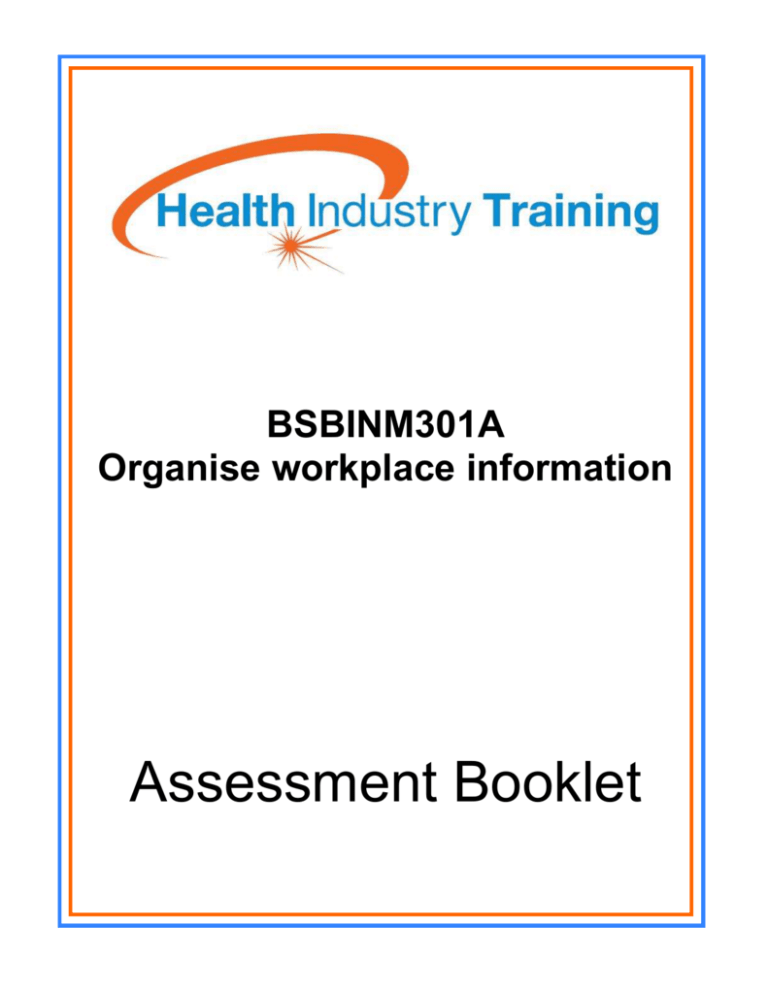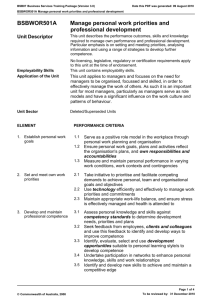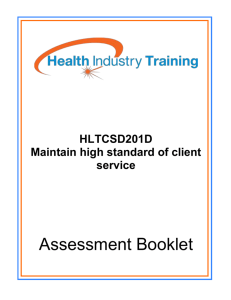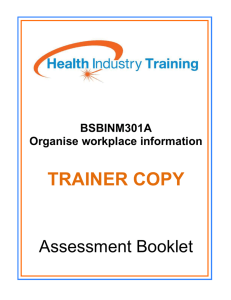HLTIN301A Comply with infection control policies and procedures
advertisement

BSBINM301A Organise workplace information Assessment Booklet © Copyright 2011 GP Links Wide Bay trading as Health Industry Training PO Box 702 HERVEY BAY 4655 Version 2: August 2012 ASSESSMENT COVER SHEET Unit Code: BSBINM301A Unit Title: Organise workplace information Trainer Comments: ________________________________________________________________________________________ ________________________________________________________________________________________ ________________________________________________________________________________________ ________________________________________________________________________________________ ________________________________________________________________________________________ ________________________________________________________________________________________ ________________________________________________________________________________________ Student Name: ___________________________________________ Student No.: ___________________ Date Due: _____ / _____ / _____ Date Submitted: _____ / _____ / _____ Student Declaration: I declare that I understand how assessment will take place for this unit. I also understand that work completed towards this assessment must be verifiably my own. __________________________________ _____________________________________ ______________ Student Name Student signature Date Trainer Sign-off: I declare the above named student was assessed by me for the above mentioned unit __________________________________ _____________________________________ ______________ Trainer Name Trainer signature Date BSBINM301A Organise workplace information Assessment tool ASSESSMENT INFORMATION Competency based assessment The standards used to determine competency in different industry sectors are developed in conjunction with the relevant Industry Training Advisory Board (ITAB). These standards are endorsed by government in the form of specific industry national training packages. Assessment in a competency based course determines when competency has been achieved. To be assessed as competent a student must provide evidence that demonstrates they can perform the necessary skills and performances required including employability skills. To be competent a student is required to consistently demonstrate the skills, knowledge and performance criteria that are necessary to confidently complete the work tasks in a normal range of workplace conditions. The trainer/assessor is responsible for ensuring the evidence gathered by a student is: Authentic (verifiable the student’s own work) Valid (evidence is relevant to the unit of competency) Reliable (the student consistently meets the requirements of the unit of competency) Current (reflects the student’s current capacity to perform the tasks); and Sufficient (covers all the elements in the unit of competency and addresses the dimensions of competency) Dimensions of assessment The dimensions of competency relate to all aspects of work performance and include: Task skills: The student must perform the individual skills required to complete a work activity to the required standards. Task management skills: The student must manage a number of different tasks to complete a whole work activity. Contingency management skills: The student must use their problem-solving skills to resolve issues that arise when performing a work activity. Job/role environment skills: The student must perform effectively in the workplace when undertaking a work activity by working well with all stakeholders and following workplace policies and procedures. Access and equity All workers in the health and community services should be aware of access, equity and human rights issues in relation to their own area of work. They should develop their ability to work in a culturally diverse environment. Trainers and assessors must take into account relevant access and equity issues including the concept of social inclusion which ensures equitable access to services, to connect with others and to protect an individual’s right to be heard. Trainers and assessors must ensure the assessment process: is valid, reliable, flexible and fair is basis of sufficient evidence is one which offers valid, authentic and current evidence includes workplace requirements in a normal range of workplace conditions Health Industry Training Page 1 BSBINM301A Organise workplace information Assessment tool UNIT INFORMATION Unit code BSBINM301A Unit title Organise workplace information Unit descriptor This unit describes the performance outcomes, skills and knowledge required to gather, organise and apply workplace information in the context of an organisation's work processes and knowledge management systems. Employability skills This unit contains employability skills. Application of the unit This unit contains employability skills including communication, teamwork, problem solving, initiative and enterprise, planning and organising, self management, learning and technology Unit sector or competency field None specified Pre-requisite, co-requisite or interdependent assessment of units None specified Context of and specific resources for assessment Method of assessment Assessment may include observation, questioning and evidence gathered from the workplace or simulated environment Critical aspects for assessment Providing accurate information for defined purposes Maintaining and handling data and documents systematically Checking and reviewing data for relevance and accuracy Presenting information and data clearly Identifying and complying with organizational requirements Using business technology to manage information Required skills and knowledge Required knowledge: Health Industry Training This unit can be assessed independently; however holistic assessment practice with other community services units of competency is encouraged. Resources required for assessment include access to: - An appropriate workplace where assessment can take place or simulation of realistic workplace setting for assessment key provisions of relevant legislation from all forms of government that may affect aspects of business operations, such as: - anti-discrimination legislation - ethical principles - codes of practice - privacy laws - occupational health and safety (WHS) methods for checking validity of information and its sources organisational recordkeeping/filing systems, security procedures and safe recording practices policies and procedures relating to distribution of workplace information, and legal and ethical obligations. Knowledge of preparing and planning documentation Page 2 BSBINM301A Organise workplace information Assessment tool Required skills: analytical skills to classify and report information literacy skills to read and understand a variety of texts; and to write, edit and proofread documents to ensure clarity of meaning, accuracy and consistency of information problem-solving skills to deal with information which is contradictory, ambiguous, inconsistent or inadequate technology skills to display information in a format suitable to the target audience Element Performance Criteria 1. Collect and assess information 1.1 Access product and service information in accordance with organisational requirements 1.2 Ensure methods of collecting information are reliable and make efficient use of available time and resources 1.3 Assess information for clarity, accuracy, currency and relevance to intended tasks 1.4 Use interpersonal skills to access relevant information from teams and individuals 2.1 Organise information in a format suitable for analysis, interpretation and dissemination in accordance with organisational requirements 2.2 Use appropriate technology/systems to maintain information in accordance with organisational requirements 2.3 Collate information and materials, and communicate to relevant designated persons 2.4 Identify difficulties organising and accessing information and solve collaboratively with individuals and team members 2.5 Update and store information in accordance with organisational requirements and systems 3.1 Actively seek feedback on clarity, accuracy and sufficiency of information to ensure relevance of information and system 3.2 Review the contribution of information to decision making and implement appropriate modifications to collection processes 3.3 Identify future information needs and incorporate in modifications to collection processes 3.4 Document future information needs and incorporate in modifications to reporting processes 2. Organise information 3. Review information needs Health Industry Training Page 3 BSBINM301A Organise workplace information Assessment tool ASSESSMENT TOOLS Assessment is conducted throughout the course using different assessment tools including written/oral assessment, projects, observation, third party reports, simulation/case studies and portfolios. Both skills and knowledge are assessed in line with the requirements of the Australian Quality Training Framework (AQTF) and the training package. Health Industry Training will use different methods of assessment to ensure sufficient evidence can be gathered to demonstrate a student can perform a task against the specified criteria. Assessment methods can include: Questioning: questions asked orally or in a written format. Written questioning is widely used in competency based assessment to assess a student’s understanding and knowledge of the task they are performing. Projects: are used for relevant units that require students to demonstrate a high level of research and analytical skills. Observation: practical demonstration of real work or simulation by the trainer Third party reports: confirmation of consistent performance by the student to meet key performance indicators over time and a range of contexts. Simulation/Case-study: simulation of the workplace to gauge competency. Demonstrated performance knowledge against a define case study or scenario. Portfolio: collection of individual pieces of evidence to demonstrate work outputs by the student. Evidence can be gathered from day to day work, certificated learning and other activities such as past achievements. Other assessment activities determined by the trainer could include a range of assessment tools appropriate for this unit to demonstrate competencies which sufficiently address: The elements and performance criteria Critical aspects for assessment The essential skills and knowledge The context and consistency of the assessment requirements The relevant employability skills Recognition of Prior Learning Recognition of Prior Learning (RPL) is a formal recognition of your current skills and knowledge you have achieved outside the education and training system. RPL takes into account any previous formal study, work and life experience and then assesses this against the elements of competency to determine if you can receive credit toward a qualification. Students seeking recognition can apply by contacting the Manager Health Industry Training at the commencement of study. Credit Transfer Students who have completed a formal unit within their intended qualification with another Registered Training Organisation (RTO) may be able to apply for a credit transfer or exemption. A certified copy of the original documentation must be provided when applying for a credit transfer. Health Industry Training Page 4 BSBINM301A Organise workplace information Assessment tool ASSESSMENT INSTRUCTIONS Assessment format and layout All assessments must be: Typed in Arial 12, single spacing with headings in bold Header and Footer to be inserted in each page. Header to include unit code and title. Footer to include student name and page number All work must be referenced throughout the assessment. Referencing should include author and year of publication and website address (if applicable). There are many referencing guides available on the Internet to assist students. Plagiarism Plagiarism is the act of representing as one's own original work the creative works of another, without appropriate acknowledgment of the author or source. In all written work submitted for assessment you must show the sources for your material. The principle is that whenever submitted material is not your own original work this must be referenced to acknowledge the author’s work. It is expected that when a student submits an assessment that it is the independent work of that student and they have written it in their own words. If a student has plagiarised another person’s work they will be asked to resubmit their assessment. Plagiarism can lead to instant dismissal. Submission All assessments must be submitted in the format described. A date for submission will be set by the trainer. Assessments must be submitted on or before this date or an extension must be granted by the trainer. The assessment cover sheets must be detached from the assessment booklets and attached to the front of each assessment. All sections of the cover sheet must be completed by the student prior to submission of assessment. The bottom section of the assessment cover sheet will be retained by the trainer. Resubmitting assessments If a student is marked ‘not competent’ they will be provided with an alternative assessment for completion to be able to demonstrate competency. An assessment resubmission should be treated as the original assessment with all principles applying. Health Industry Training Page 5 BSBINM301A Organise workplace information Assessment tool ASSESSMENT - BSBINM301A Organise workplace information In your own words, answer the following questions. To be marked as competent in this unit, you must provide sufficient responses to each question. Bullet points must only be used where applicable eg: if the question asks you to list, name or give examples. Questions Question 1: For what reasons might information be unreliable or invalid? Why do you need to be careful of information posted on the internet? How can you determine if information is reliable and valid? Question 2: Identify and describe three forms of security that can be implemented to protect information from misuse, loss, unauthorised access, modification or disclosure. Question 3: How can workplace information be distributed or disseminated to employees? Provide at least five examples. Question 4: What are the most common classifications for filing records and information? Provide a brief explanation of each Question 5: Why is it necessary to have a working knowledge of the legislation involved in an organisation? Question 6: What control information should be recorded to describe new records in an organisation? To be marked competent in this unit, students must respond to all points in the project. Answers must be comprehensive, detailed, demonstrate appropriate research procedures and be supported by suitable references. Project You are required to explain how you would collect, organise and distribute information in the workplace. As a part of this explanation you will need to give details of: what sources of information are available within the workplace how you can determine the reliability, accuracy, currency, relevancy and usefulness of the data and information you collect why old, wrong, distorted or incomplete information is not useful information how you can use interpersonal skills to access information the various ways information can be formatted why free and open sharing of information is essential to organisational success how legislation such as the Privacy Act 1988 and the Freedom of Information Act 1982 impact on your ability to collect, store and share information how you can use technology to store, organise and disseminate information how information and records can be stored how information can be kept secure the problems you might run into when trying to access information how information is used to make decisions how you can determine the information that might be needed by your organisation in the future how you can access the effectiveness of the organisation's information system You can do this in a format of your choice. You might choose to present your response as a report or essay. You might choose to create a PowerPoint presentation, a speech or an instructional booklet that could be used by professionals required to organise workplace information. Your responses should demonstrate a clear understanding of the learning materials presented in this unit. You should provide original examples to support your explanation. Health Industry Training Page 6









